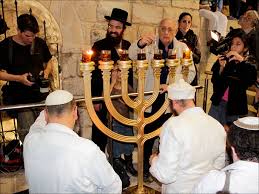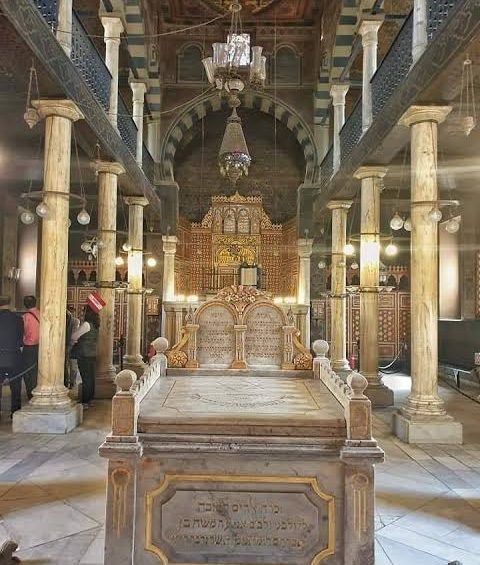Ben Ezra Synagogue
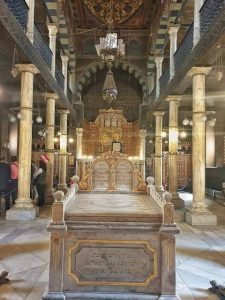
The Ben Ezra Synagogue
The Ben Ezra Synagogue is one of the most important Jewish synagogues in Egypt and is located in the Old Cairo district of Fustat. It has historical and religious significance and has a deep history dating back to the Middle Ages, as it was built in the ninth century AD. It has been restored and rebuilt several times. It is commonly believed that the site of the Jewish synagogue was formerly a Coptic church called the Church of the Shammain. The church faced a financial crisis, so the Jews bought it and converted it into a Jewish synagogue and named it the Synagogue of Ben Ezra, who is a historical figure and considered one of the great rabbis of the Jews and has a great place in Jewish heritage. He is one of the most famous writers of the Torah
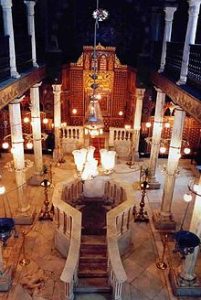 The design of the Ben Ezra Synagogue is distinguished by the Islamic architectural style that was prevalent in Fustat and Cairo in the Middle Ages. It contains many inscriptions and decorations that bear Jewish symbols, and a ceiling with complex designs. The synagogue is of a basilican style, consisting of three aisles, the most important of which is the central aisle. It includes a marble structure with inscriptions in Hebrew that describe how our Lord Moses supplicated to his Lord in that place. Following the marble structure is what is called the bema, which is for the Jewish religious leader to ascend for performing prayers and giving sermons and lectures. Then comes the wooden sanctuary inlaid with ivory and ebony.”
The design of the Ben Ezra Synagogue is distinguished by the Islamic architectural style that was prevalent in Fustat and Cairo in the Middle Ages. It contains many inscriptions and decorations that bear Jewish symbols, and a ceiling with complex designs. The synagogue is of a basilican style, consisting of three aisles, the most important of which is the central aisle. It includes a marble structure with inscriptions in Hebrew that describe how our Lord Moses supplicated to his Lord in that place. Following the marble structure is what is called the bema, which is for the Jewish religious leader to ascend for performing prayers and giving sermons and lectures. Then comes the wooden sanctuary inlaid with ivory and ebony.”
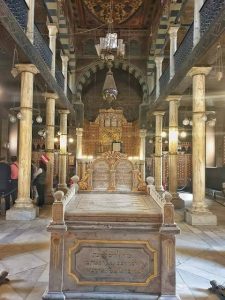 the sanctuary is composed of two wooden panels with beautiful geometric and botanical decorations, adorned with coloring and gilding. Above the sanctuary, there are 10 Hebrew phrases divided into two parts: the Ten Commandments of our Lord Moses, peace be upon him. In front of the sanctuary are 2 candelabras, each a copper holder carrying six lit lamps and a dark hexagonal star in the middle, which refers to the Jewish belief that God created the heavens and the earth in six days, symbolized by the 6 lit lamps, then He stopped due to fatigue and weariness on the seventh day, which is represented by the dark hexagonal star, corresponding to the Sabbath, which is a sad day on which Jews perform many special rituals and ceremonies. We also find the interior of the synagogue influenced by Islamic decorations, such as star-shaped plates and distinctive arabesque decorations that adorn the first floor and ceilings. There is also an upper floor that was reserved for women to perform their special religious rituals.”
the sanctuary is composed of two wooden panels with beautiful geometric and botanical decorations, adorned with coloring and gilding. Above the sanctuary, there are 10 Hebrew phrases divided into two parts: the Ten Commandments of our Lord Moses, peace be upon him. In front of the sanctuary are 2 candelabras, each a copper holder carrying six lit lamps and a dark hexagonal star in the middle, which refers to the Jewish belief that God created the heavens and the earth in six days, symbolized by the 6 lit lamps, then He stopped due to fatigue and weariness on the seventh day, which is represented by the dark hexagonal star, corresponding to the Sabbath, which is a sad day on which Jews perform many special rituals and ceremonies. We also find the interior of the synagogue influenced by Islamic decorations, such as star-shaped plates and distinctive arabesque decorations that adorn the first floor and ceilings. There is also an upper floor that was reserved for women to perform their special religious rituals.”
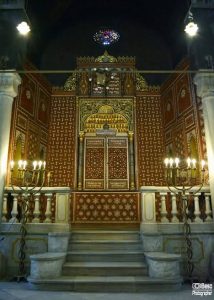 The synagogue was well-known among Egyptians as the Geniza Synagogue, as the synagogue, and indeed all Jewish synagogues in Egypt, received many geniza papers in preparation for sending them on a specific day during the year to be buried in the Jewish cemeteries of al-Basatin, which is the second largest Jewish cemetery in the world. It was customary for Jews to write various daily events on small pieces of paper, which were then placed in the Jewish synagogues initially, in preparation for their transfer from all synagogues on a specific day of the year to the cemeteries where they would be buried, to serve as a witness to the lives of the Jews before God on the Day of Judgment. It should be noted that the papers that were inside the synagogue in preparation for being sent to the cemeteries were not sent for long periods, until they were forgotten about until the arrival of the German scholar, Schachter, who took all these papers of scientific and cultural importance to Germany, depriving Egypt of a vast scientific wealth.
The synagogue was well-known among Egyptians as the Geniza Synagogue, as the synagogue, and indeed all Jewish synagogues in Egypt, received many geniza papers in preparation for sending them on a specific day during the year to be buried in the Jewish cemeteries of al-Basatin, which is the second largest Jewish cemetery in the world. It was customary for Jews to write various daily events on small pieces of paper, which were then placed in the Jewish synagogues initially, in preparation for their transfer from all synagogues on a specific day of the year to the cemeteries where they would be buried, to serve as a witness to the lives of the Jews before God on the Day of Judgment. It should be noted that the papers that were inside the synagogue in preparation for being sent to the cemeteries were not sent for long periods, until they were forgotten about until the arrival of the German scholar, Schachter, who took all these papers of scientific and cultural importance to Germany, depriving Egypt of a vast scientific wealth.
 the Ben Ezra Synagogue was an educational center for members of the Jewish community. It was a place for Jews from all social classes to gather, where they would meet on religious and social occasions and strengthen their bonds. It played an important role in community communication, as well as in strengthening religious and cultural identity and enabling them to preserve their traditions and customs. The location of the synagogue in one of the most important Jewish neighborhoods had a great impact on the knowledge of many details of the lives of Jews in Egypt and the Mediterranean basin during the Middle Ages
the Ben Ezra Synagogue was an educational center for members of the Jewish community. It was a place for Jews from all social classes to gather, where they would meet on religious and social occasions and strengthen their bonds. It played an important role in community communication, as well as in strengthening religious and cultural identity and enabling them to preserve their traditions and customs. The location of the synagogue in one of the most important Jewish neighborhoods had a great impact on the knowledge of many details of the lives of Jews in Egypt and the Mediterranean basin during the Middle Ages
